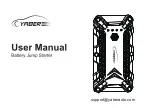
Quick installation Guide
http://www.autostart.ca P.9
WARNING:
The vehicle is not
armed or locked down.
WARNING:
Engine runs until the pre-
programmed run time expires.
WARNING:
Do not leave your
keys in the vehicle!
6. The Parking lights will flash
twice
to indicate Ready mode is set.
The system will exit ready mode if a door, the hood or the trunk is opened, if the brake pedal is pres-
sed, if the parking brake is disengaged or if the ignition key is turned to the
IGNITION ON (RUN)
position.
Remote-start the engine and listen for starter drag.
If the starter cranks for too long, carry out
another tach programming procedure or VTS adjustment
(page 7)
.
Hood switch shutdown.
With the vehicle running under the remote car starter, open the hood; the
vehicle should shut down. If it does not shut down, check the hood pin-switch and its connector.
Brake shutdown circuit.
With the vehicle running under the remote car starter, press and release the
brake pedal. The engine should shut down immediately. If it continues to run, check the brake switch
connection.
Parking brake shutdown circuit (manual transmissions only).
With the vehicle running under
remote start, disengage the parking brake. The engine should shut down immediately. If the engine
continues to run, check the parking brake switch connection.
OEM alarm control.
Make sure the module is able to arm and disarm the OEM alarm (if applicable).
Door locks and trunk testing.
Make sure each of these options respond to the transmitter (if
installed).
Door pin shutdown circuit (manual transmissions only).
Make sure the system exits ready mode
when each door is opened. (Test each door.)
Starter kill option.
Sit inside the vehicle with all doors closed. Arm the vehicle, then try to start the
engine with the key. The engine should not start. If the engine starts, rewire the starter kill to reach
proper operation.
Valet mode.
Make sure the remote car starter is able to properly enter and exit valet mode. When
setting the remote car starter into valet mode, pressing the lock button will lock the doors without
activating the starter kill. (Refer to the user guide for further information on valet mode.)
Idle mode.
Make sure the vehicle properly enters and exits idle mode.
Door.
Make sure that when the system is armed, opening any door or opening the trunk will trigger
the alarm (if installed).
Hood trigger.
Make sure that when the system is armed, opening the hood should trigger the alarm.
Most comebacks are the result of misunderstandings about how a product works or performs.
Take the time to properly explain all functions and features to the customers before they leave
the premises. Doing this will save time and money.
P.2 http://www.autostart.ca
Quick Installation Guide
About synchronization
x
Disconnecting the bypass module and remote starting the vehicle without any bypass module connected
will NOT cause the remote starter module and the ADS bypass to be out of synchronization.
x
Disconnecting the battery of the vehicle will NOT cause the remote starter module and the ADS bypass
to be out of synchronization.
x
Upon remote starting the vehicle; the remote starter communicates with the ADS bypass module thru the
supplied ADS data cable. Since the communication is set in 2 way communication, the remote starter is
waiting for a confirmation back from the ADS bypass module that it acknowledges upon the start
command. If no answer back from the ADS bypass module, the remote starter will wait for the bypass
module answer in order to change the encrypted code.
x
The EncryptR™ is now the safest way to prevent theft from stealing vehicles by using the remote starter.
Using the supplied ADS data cable and the EncryptR™ encryption makes the installation safer than ever
and cannot be tampered with by generating the “Out When Running” signal in the ADS data cable to
override the security on the vehicle.
MANUAL OR AUTOMATIC TRANSMISSION SETUP
This module may be installed on vehicles with manual or automatic transmissions. It is originally configured for
manual transmissions. If the vehicle you are working on is automatic, it is mandatory to make a few quick and
easy modifications before the unit is connected. In the event that the configuration requires changes afterwards,
a complete reset
(page 7)
will be necessary before those changes become effective.
To install this unit in a vehicle with a
MANUAL
transmission:
1.
Make sure the Yellow loop on the PC board is connected (default).
2.
Connect the Orange handbrake wire located on the 12-pin harness to the vehicle handbrake
circuit.
3.
Connect the Blue/White (+) door input OR the Grey (-) door input wire located on the 12-pin
harness to the vehicle door pin wire which monitors all the doors of the vehicle (only use 1 of the 2
door trigger inputs). Make sure the Purple TACH wire is wired to a tach source – the TACH wire
MUST be hooked up when the module is set for a manual transmission.
4.
Make all your regular connections.
5.
Power up the unit by first inserting the 5-pin connector, then the 6-pin connector and finally the 12-
pin connector. The parking lights will flash 4 times.
6.
When learning the transmitter, the parking lights will flash 5 times quickly.
7.
Upon the first successful remote start, the system will lock the transmission settings to manual
mode.
To install this unit in a vehicle with an
AUTOMATIC
transmission:
1.
Cut the loop on the pc board (Yellow wire).
2.
Make sure the Orange handbrake wire is not connected to any of the vehicle circuits.
3.
Make all the regular connections.
4.
Power up the unit by first inserting the 5-pin connector, then the 6-pin connector and finally the 12-
pin connector. The parking lights will flash 4 times.
5.
When learning the first transmitter, the parking lights will flash 5 times quickly then give 2 slow
flashes.
6.
Upon the first successful remote start (once the yellow loop has been cut), the system will lock the
transmission settings to automatic mode.
Note:
If upon pressing the
START
button the parking lights give 3 slow flashes, make sure that the Orange
handbrake wire is not connected, the hand brake is not engaged and that the yellow loop is cut and
isolated/taped.
DIESEL VEHICLE WARNING:
The G-Plug wire must not be connected when the brake is detected through
D2D.
PUSH-TO-START
Disabled by default, PTS mode is a special feature that is intended to facilitate the remote starter installation on
most Push-To-Start vehicles. With PTS mode enabled, the remote starter will offer the installer a negative start
output (to pulse the vehicle’s PTS switch), as well as a (+) brake switch output (no external relay necessary).
With PTS enabled, the White/Green wire on the 12-pin harness becomes your negative (-) PTS switch output. It
























